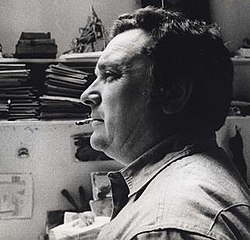Jean Messagier
| Jean Messagier | |
|---|---|

Portrait photograph of the artist
|
|
| Born | 13 July 1920 |
| Died | 10 September 1999 (aged 79) |
| Nationality | French |
| Education | École nationale supérieure des arts décoratifs, Paris |
| Known for | Painting, Drawing, Sculpture, Printmaking, Writing, Poetry |
| Notable work | Nature morte (1944-45), Les Arroseurs (1947), Femmes aux Nasses (1947), Promeneurs (1947), Jeune Filles a la Casacade (1949), Haute promenade (1954), Monstres d'été (1967), Le Sexe des vallées (1970) |
| Movement | Post-Cubism, Lyrical abstraction, Tachisme, Nuagisme, art informel |
| Awards | Chevalier de l’ordre national des arts et lettres, Chevalier de la légion d’honneur, Officier de l’ordre national des arts et lettres, Commandeur dans l’office national du mérite. |
Jean Messagier (Paris, 13 July 1920 – Montbéliard, 10 September 1999) was a French painter, sculptor, printmaker and poet. Jean Messagier had his first solo exhibition in Paris at Galerie Arc-en-Ciel in 1947. From 1945 to 1949 the artist worked under the influence of Pablo Picasso, André Masson, Paul Klee and François Desnoyer, his professor at École nationale supérieure des arts décoratifs in Paris. Messagier again was revealed to the public at an exhibition organized by at the Galerie de Babylone in 1952, entitled "La Nouvelle École de Paris" (The New School of Paris). The following year, Messagier deliberately broke away from his expressionistic form of Post-Cubism; his inspirations now focused on Jean Fautrier and Pierre Tal-Coat to develop a personal vision in which he renders "light...approached abstractly." Jean Messagier is often associated with Lyrical abstraction, Tachisme, Nuagisme, Art informel and paysagisme abstrait, though the artist himself had never accepted any labels, and had always refused the distinction between abstraction and figuration. From 1962 until the year of his death Jean Messagier exhibited in France and abroad, taking part in some major international events as a representative of new trends in French painting.
Jean Messagier spent his childhood during the 1920s and 1930s between Paris and Franche-Comté, where he realized his first representational watercolors and drawings (1940); portraits and landscapes. He first exhibited his works in a group show at the Salon des Moins de Trente Ans in Paris (1941), before participating regularly in Parisian salons: Salon des Moins de Trente Ans, Paris, 1941–51; Salon d'Automne, 1947–52; Salon de Mai, 1948–53; Jeune Gravure Contemporaine, 1950; Young Painters of the Ecole de Paris, Royal Scottish Academy, Edinburgh, 1952; Mostra dell'Incisione Francese Contemporanea, Milan, 1953; Galerie L'Étoile scellée and Galerie Craven, Paris, 1953. Messagier would soon be represented at group exhibitions in Germany, Zurich, Florence, Brussels, London and the Solomon R. Guggenheim Museum in New York. He would also participate in the Salon des Réalités Nouvelles, Salon Comparaisons, Peinture informelle (alongside Jean Fautrier, Hans Hartung, Jean-Paul Riopelle, Mark Tobey, Wols) and the Salon d’Octobre of which he was one of the founding members.
...
Wikipedia
